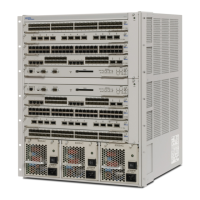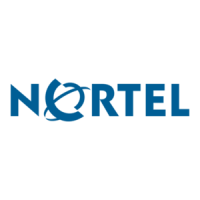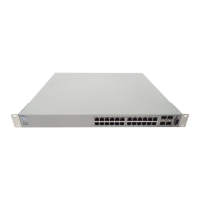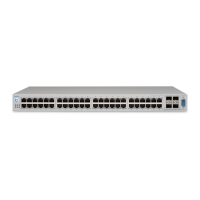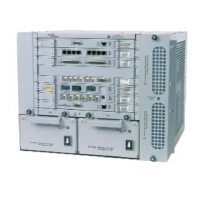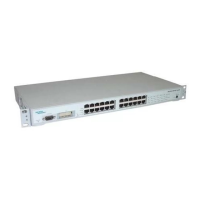Do you have a question about the Nortel Passport 8250 and is the answer not in the manual?
Identifies the intended audience for the Passport 8250 Command Line Interface Guide.
Lists prerequisite knowledge and topics required before using this guide.
Explains the structure and content covered in the various sections of the guide.
Explains text formatting, syntax, and typographical conventions used throughout the document.
Defines the meaning of special symbols and characters used in the CLI commands and text.
Lists related Passport documentation for ATM services and installation.
References NMS documents relevant to network management and tools.
Cites RFC documents related to standard management information bases.
Provides contact information for obtaining technical support and services from Nortel.
Provides an overview of the Passport 8250 as an Integrated Access MUX bridging voice and ATM networks.
Details the key functionalities, capabilities, and benefits of the Passport 8250 device.
Lists the management information bases (MIBs) supported by the Passport 8250 for network management.
Describes the Passport 8250's compliance with ATM Forum CES-IS and support for AAL1 CBR service.
Outlines the CLI, NMS Passport 8250 Tools, and MIB browser used for device management.
Explains how to derive and configure the clocking scheme for the Passport 8250 device.
Details the CBR clocking modes supported for structured and unstructured services on the Passport 8250.
Describes the integrated fault management capabilities provided by the Network Management System (NMS).
Covers the storage of system software and configuration data in the Passport 8250's flash memory.
Introduces the command line interface (CLI) as a terminal-based system for managing the Passport 8250.
Explains the visual layout and text command entry process of the CLI interface.
Details the composition of the CLI prompt, including traffic interface and board slot indicators.
Provides methods for accessing the CLI, including direct connection and remote Telnet sessions.
Explains the priority order for CLI sessions when accessed from different sources.
Step-by-step instructions for initiating a CLI session using username and password.
Describes how to modify the user password using the `passwd` command for security.
Explains how to access and manage specific hardware boards within the Passport 8250 via the CLI.
Guides users on how to utilize the CLI's built-in help feature for commands and syntax.
Procedure for terminating an active CLI session gracefully using the `exit` command.
Details the process of rebooting the Passport 8250 device directly from the CLI using the `reboot` command.
Provides a reference list of available CLI commands and their explanations within the document.
Instructions for configuring port parameters like line type, line coding, and signal mode for DS-1/E1 interfaces.
Step-by-step procedure for altering specific port configuration parameters.
How to display the current configuration status of DS-1/E1 ports on a service board.
Explains the process and requirements for creating various types of connections using the CLI.
Outlines the rules and constraints for assigning Virtual Path Identifiers (VPI) and Virtual Channel Identifiers (VCI).
Describes the rules and grouping of time slots for provisioning structured connections.
Specifies the rules for setting the signal mode for different connection types (e.g., E1 CAS).
Explains the rules for Constant Bit Rate (CBR) clocking for both unstructured and structured services.
Details the syntax and parameters of the `map` command for creating DS-1/E1 connections.
Provides a procedure for establishing unstructured connections using the CLI.
Guides users through the process of creating structured Basic and CAS connections.
Explains methods to display existing connections associated with specific ports.
Utilizes the `mshow` command to search and display connections based on port number.
Employs the `vshow` command for locating connections using VPI or VPI/VCI identifiers.
Describes how to remove established connections from the system using the `unmap` command.
Explains how to use the `ping` command to test network reachability to remote hosts.
Details the `ibconfig` command for setting up in-band management on the ATM uplink port.
Covers the `urconfig` command for setting up redundant uplink ports and switching methods.
Instructions for changing the device's boot parameters using the `bootconfig` command.
Guides on updating SNMP community strings for network management using the `snmpcs` command.
Explains how to enable or disable alarm and information messages displayed in the CLI.
Describes the fault log, its contents, and how it aids in identifying and resolving issues.
Instructions for viewing the status of boards and the current software version of the Passport 8250.
Provides an overview of the organization and hierarchy of the Passport 8250's flash file system.
Details basic commands like `cd`, `dir`, and `pwd` for navigating the flash file system.
Explains the procedure to load alternative software versions using the `bootpath` command.
Outlines the steps required to download new system software onto the Passport 8250 via FTP.
Provides instructions and tables for converting time slot selections into hexadecimal values for connection provisioning.
Details the structure and contents of the Passport 8250's Enterprise MIB tables.
Lists and describes the standard management information bases (MIBs) supported by the Passport 8250.
Identifies the intended audience for the Passport 8250 Command Line Interface Guide.
Lists prerequisite knowledge and topics required before using this guide.
Explains the structure and content covered in the various sections of the guide.
Explains text formatting, syntax, and typographical conventions used throughout the document.
Defines the meaning of special symbols and characters used in the CLI commands and text.
Lists related Passport documentation for ATM services and installation.
References NMS documents relevant to network management and tools.
Cites RFC documents related to standard management information bases.
Provides contact information for obtaining technical support and services from Nortel.
Provides an overview of the Passport 8250 as an Integrated Access MUX bridging voice and ATM networks.
Details the key functionalities, capabilities, and benefits of the Passport 8250 device.
Lists the management information bases (MIBs) supported by the Passport 8250 for network management.
Describes the Passport 8250's compliance with ATM Forum CES-IS and support for AAL1 CBR service.
Outlines the CLI, NMS Passport 8250 Tools, and MIB browser used for device management.
Explains how to derive and configure the clocking scheme for the Passport 8250 device.
Details the CBR clocking modes supported for structured and unstructured services on the Passport 8250.
Describes the integrated fault management capabilities provided by the Network Management System (NMS).
Covers the storage of system software and configuration data in the Passport 8250's flash memory.
Introduces the command line interface (CLI) as a terminal-based system for managing the Passport 8250.
Explains the visual layout and text command entry process of the CLI interface.
Details the composition of the CLI prompt, including traffic interface and board slot indicators.
Provides methods for accessing the CLI, including direct connection and remote Telnet sessions.
Explains the priority order for CLI sessions when accessed from different sources.
Step-by-step instructions for initiating a CLI session using username and password.
Describes how to modify the user password using the `passwd` command for security.
Explains how to access and manage specific hardware boards within the Passport 8250 via the CLI.
Guides users on how to utilize the CLI's built-in help feature for commands and syntax.
Procedure for terminating an active CLI session gracefully using the `exit` command.
Details the process of rebooting the Passport 8250 device directly from the CLI using the `reboot` command.
Provides a reference list of available CLI commands and their explanations within the document.
Instructions for configuring port parameters like line type, line coding, and signal mode for DS-1/E1 interfaces.
Step-by-step procedure for altering specific port configuration parameters.
How to display the current configuration status of DS-1/E1 ports on a service board.
Explains the process and requirements for creating various types of connections using the CLI.
Outlines the rules and constraints for assigning Virtual Path Identifiers (VPI) and Virtual Channel Identifiers (VCI).
Describes the rules and grouping of time slots for provisioning structured connections.
Specifies the rules for setting the signal mode for different connection types (e.g., E1 CAS).
Explains the rules for Constant Bit Rate (CBR) clocking for both unstructured and structured services.
Details the syntax and parameters of the `map` command for creating DS-1/E1 connections.
Provides a procedure for establishing unstructured connections using the CLI.
Guides users through the process of creating structured Basic and CAS connections.
Explains methods to display existing connections associated with specific ports.
Utilizes the `mshow` command to search and display connections based on port number.
Employs the `vshow` command for locating connections using VPI or VPI/VCI identifiers.
Describes how to remove established connections from the system using the `unmap` command.
Explains how to use the `ping` command to test network reachability to remote hosts.
Details the `ibconfig` command for setting up in-band management on the ATM uplink port.
Covers the `urconfig` command for setting up redundant uplink ports and switching methods.
Instructions for changing the device's boot parameters using the `bootconfig` command.
Guides on updating SNMP community strings for network management using the `snmpcs` command.
Explains how to enable or disable alarm and information messages displayed in the CLI.
Describes the fault log, its contents, and how it aids in identifying and resolving issues.
Instructions for viewing the status of boards and the current software version of the Passport 8250.
Provides an overview of the organization and hierarchy of the Passport 8250's flash file system.
Details basic commands like `cd`, `dir`, and `pwd` for navigating the flash file system.
Explains the procedure to load alternative software versions using the `bootpath` command.
Outlines the steps required to download new system software onto the Passport 8250 via FTP.
Provides instructions and tables for converting time slot selections into hexadecimal values for connection provisioning.
Details the structure and contents of the Passport 8250's Enterprise MIB tables.
Lists and describes the standard management information bases (MIBs) supported by the Passport 8250.
| Product Type | Switch |
|---|---|
| Form Factor | Rack-mountable |
| Manageable | Yes |
| Jumbo Frame Support | Yes |
| Power Supply | Redundant |
